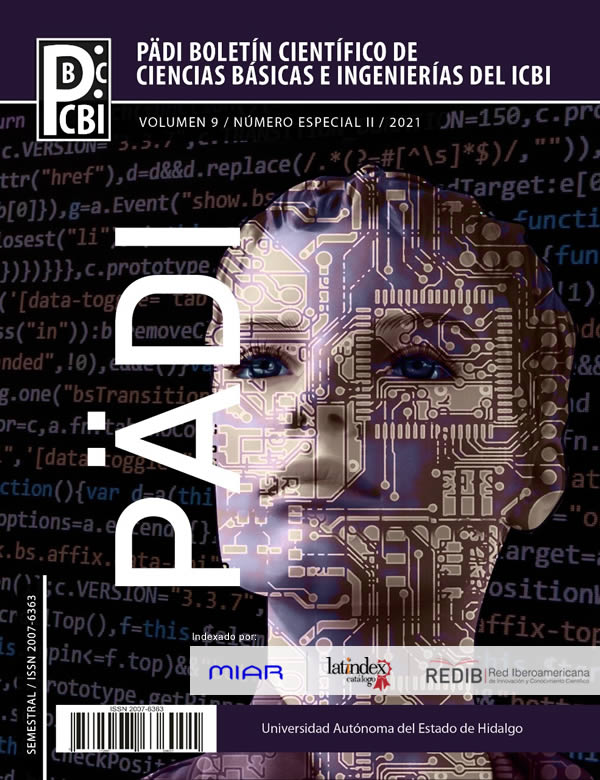Estudio TFD de cúmulos de Pt-Ir con geometría prisma triangular
DOI:
https://doi.org/10.29057/icbi.v9iEspecial2.7996Palabras clave:
Cúmulos, Bimetálicos, Platino, Iridio, TFDResumen
En este trabajo, se presenta un estudio sistemático de las propiedades estructurales y electrónicas de cúmulos bimetálicos de Pt6−nIrn donde n = [0 – 6] usando la metodología B3LYP/LanL2DZ en el contexto de la teoría de los funcionales de la densidad (TFD). Las estructuras de los cúmulos puros Pt6 e Ir6 muestran arreglos tridimensionales altamente estables con multiplicidades electrónicas (μ) entre 7 y 13. El cúmulo puro de Pt6 más estable adopta una geometría de prisma triangular. Para la evaluación de los cúmulos dopados Pt6−nIrn (n = [0 – 6]) se determinó la longitud de enlace promedio, las cargas de Mulliken, los orbitales moleculares frontera y el mapeo del potencial electrostático. La evaluación de las propiedades electrónicas y estructurales demuestra que la incorporación de átomos de iridio en cúmulos de platino modifica su reactividad.
Descargas
Información de Publicación
Perfiles de revisores N/D
Declaraciones del autor
Indexado en
- Sociedad académica
- N/D
Citas
Bhattacharyya, K., & Majumder, C. (2007). Growth pattern and bonding trends in Ptn (n= 2–13) clusters: Theoretical investigation based on first principle calculations. Chemical Physics Letters, 446(4-6), 374-379. https://doi.org/10.1016/j.cplett.2007.08.084
Chen, M., & Dixon, D. A. (2013). Low-Lying Electronic States of Ir n Clusters with n= 2–8 Predicted at the DFT, CASSCF, and CCSD (T) Levels. The Journal of Physical Chemistry A, 117(17), 3676-3688. DOI: 10.1021/jp4014465
Chen, Y., Huo, M., Chen, T., Li, Q., Sun, Z., & Song, L. (2015). The properties of Ir n (n= 2–10) clusters and their nucleation on γ-Al 2 O 3 and MgO surfaces: From ab initio studies. Physical Chemistry Chemical Physics, 17(3), 1680-1687. DOI: 10.1039/c4cp04881d
Du, J., Sun, X., Chen, J., & Jiang, G. (2010). A theoretical study on small iridium clusters: structural evolution, electronic and magnetic properties, and reactivity predictors. The Journal of Physical Chemistry A, 114(49), 12825-12833. DOI: 10.1021/jp107366z
Frisch, M. J., Trucks, G. W., Schlegel, H. B., Scuseria, G. E., Robb, M. A., Cheeseman, J. R., ... & Fox, D. J. (2008). Gaussian 09, Revision A. 02, Gaussian, Inc., Wallingford CT, 2016 Search PubMed;(b) J. Chaia and M. Head-Gordon. Phys. Chem. Chem. Phys, 10, 6615-6620.
Guo, W., Rao, Q., & Zhang, X. (2012). Theoretical study on structure and stability of PtIrn (0,±)(n= 1-5) clusters. Chinese Journal of Computational Physics, 3.
Gao, K., Zhang, X. R., Yu, Z. C., & Huo, P. Y. (2018). Structure stability and electronic properties of PtmIrn (m+ n= 2–7) clusters: A DFT study. Computational and Theoretical Chemistry, 1138, 168-175. DOI: 10.1016/j.comptc.2018.06.016
Gao, K., Zhang, X. R., & Yu, Z. C. (2020). Structure stability and electronic properties of Pt m Ir n (m+ n= 8− 1 0) and adsorption sites of on Pt–Ir clusters at the DFT level. Surface Review and Letters, 27(05), 1950144. DOI: 10.1142/S0218625X19501440
Hamad, B., El-Bayyari, Z., & Marashdeh, A. (2014). Investigation of the stability of platinum clusters and the adsorption of nitrogen monoxide: First principles calculations. Chemical Physics, 443, 26-32. DOI: 10.1016/j.chemphys.2014.07.004
Hay, P. J., & Wadt, W. R. (1985). Ab initio effective core potentials for molecular calculations. Potentials for the transition metal atoms Sc to Hg. The Journal of chemical physics, 82(1), 270-283. DOI: 10.1063/1.448799
Heredia, C. L., Ferraresi-Curotto, V., & López, M. B. (2012). Characterization of Ptn (n= 2–12) clusters through global reactivity descriptors and vibrational spectroscopy, a theoretical study. Computational materials science, 53(1), 18-24. DOI: 10.1016/j.commatsci.2011.09.005
Hertwig, R. H., & Koch, W. (1997). On the parameterization of the local correlation functional. What is Becke-3-LYP?. Chemical Physics Letters, 268(5-6), 345-351. DOI: 10.1016/S0009-2614(97)00207-8
Li, R., Odunlami, M., & Carbonnière, P. (2017). Low-lying Ptn cluster structures (n= 6–10) from global optimizations based on DFT potential energy surfaces: sensitivity of the chemical ordering with the functional. Computational and Theoretical Chemistry, 1107, 136-141. DOI: 10.1016/j.comptc.2017.02.010
Nie, A., Wu, J., Zhou, C., Yao, S., Luo, C., Forrey, R. C., & Cheng, H. (2007). Structural evolution of subnano platinum clusters. International Journal of Quantum Chemistry, 107(1), 219-224. DOI: 10.1002/qua.21011
Sellmyer, D. J., & Skomski, R. (Eds.). (2006). Advanced magnetic nanostructures. Springer Science & Business Media. ISBN 978-0-387-23316-1
Xiao, L., & Wang, L. (2004). Structures of platinum clusters: Planar or spherical?. The Journal of Physical Chemistry A, 108(41), 8605-8614. DOI: 10.1021/jp0485035




















